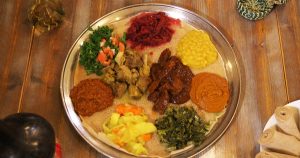How ironic is it that I researched Ethiopian food in Harlem most recently, and I got the opportunity to try one of the staple dishes. At the heart of every Ethiopian meal is Injera.
Injera is a huge spongy flatbread that looks like a fluffy pancake or better yet a really big crepe. It is made from tef, a sour-wheat-like grain that is mixed with cool water and a pinch of yeast. The batter is left up to three days to be fermented, then cooked on a griddle.
The Ethiopian tradition of injera is served on a platter and is used as a plate, to sop up vegetables and stews called wat. Stews can include beef, chicken or lamb and different dips such as string beans, dhal lentils, potatoes, peppers, lettuce or tomato based salad and mixed vegetables that are ladled on top. Pieces of the injera are broken off and used to scoop up the food, with your hands of course. In a country where utensils are scarce injera is not only your dinner plate, it’s also your knife, fork and spoon.
Upon tasting the injera, it did have a sour, tangy taste and the texture was spongy with small eyes (air pocket holes) and fluffy but soft. Ladled on top was sautéed chicken with onions, stewed potatoes and spinach. The spices in the chicken were rich and bursting with flavor, which made every bite worth it.
Feasting on injera took me down memory lane, when I attended an Indian wedding in Trinidad. There was an assortment of curries, dips and roti that was ladled and served on a huge banana leaf, except the banana leaf was not edible. Similar to the popular dish injera, the food was also eaten by hand.
Injera eaten with hands





